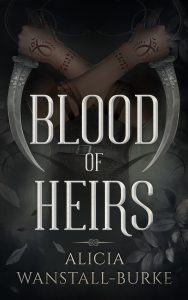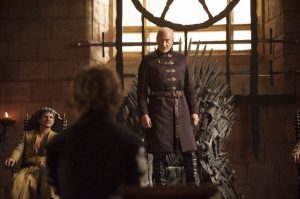Blood of Heirs by Alicia Wanstall-Burke
 Alicia Wanstall-Burke’s debut Blood of Heirs has been haunting mentions in my social media for a while now. Alicia has shared some of the highs and lows, the triumph and the angst attendant on the long gestation of a first-born book. There was even a point where she had decided to put Blood of Heirs to one side to focus on a different WIP, caught in the snowblindness of someone deeply involved in the cycle of “tweaking and refining” a work to the point that it has eroded their confidence in the quality of their work.
Alicia Wanstall-Burke’s debut Blood of Heirs has been haunting mentions in my social media for a while now. Alicia has shared some of the highs and lows, the triumph and the angst attendant on the long gestation of a first-born book. There was even a point where she had decided to put Blood of Heirs to one side to focus on a different WIP, caught in the snowblindness of someone deeply involved in the cycle of “tweaking and refining” a work to the point that it has eroded their confidence in the quality of their work.
All I can say is that I am very glad Alicia revisited that decision and decided to unleash Blood of Heirs on the world. This is a very good book, an accomplished debut that can confidently rub shoulders with a slew of recent works of fantasy fiction both traditionally published and self-published.
The people
The story has two parallel threads following the eponymous heirs of the title. We meet Lidan first, thirteen-year-old eldest daughter to Erlon Tolak Daari of the Tolak clan and – in the absence of any brothers – the Daari’s heir. And then there is Ranoth Olseta, son and heir to Duke Ronart of Orthia.
The storylines do not so much cross or touch, as weave their way around a common and formidable foe. There is a link between the farmhouse horror that Ranoth stumbles across in the midst of a desperate retreat, and the unseen attackers preying on the rangers of Lidan’s clan.
Despite the significant geographical divide that separates them, there is another tie that binds the two teenagers’ stories – a theme of what one work colleague of mine used to call PPP – or Piss-Poor Parenting. Neither Lidan nor Ran appear particularly fortunate in their parents.
Liddy’s mother Sellan reminds me of Livia, mother of Tiberius in I, Claudius, or LaVona Golden, mother of Tonya Harding so brilliantly portrayed by Allison Janey in the film I, Tonya. These are mothers whose every maternal instinct has been sacrificed in a cruelly expressed ambition for success through their offspring. Sellan’s position as first wife to the leader of the Tolak Clan offers little comfort, for she is not the only wife and has mothered only daughters in a society patriarchal by custom and practice more than by law.
For Lidan, the attacks on the rangers and the shadow falling over the Tolak and the other four clans are a backdrop to her struggle for her father’s love and her mother’s approval. Not for Liddy the traditional female role of mother and home maker; she hungers to be a ranger and a horse breaker like the men of her clan.

Tywin Lannister with Tyrion in HBO’s Game of Thrones.
Duke Ranort, Ran’s father, reminds me of Tywin Lannister, father to poor Tyrion, or even Olidan, duke of Ancrath and father of Jorg, Prince of Thorns. Ran is a far more moral and empathic creature than Jorg or even Tyrion. (Perhaps tutor Perce had more success with Ran’s ethical education than Tutor Lundist did with Jorg’s.) Duke Ranort is demanding and unforgiving, precisely the kind of father a teenage boy could be desperate to impress.
In the end, though, the thin veneer of paternal affection is burned away by the brightness of the curse that afflicts Ran, hurling the young boy on a lonelier and more dangerous path of self-discovery even than Jorg’s or Tyrion’s.
The Prose
Wanstall-Burke’s prose is comfortably fluid and effectively intriguing, a combination that lures you into turning just one more page deep into the night until fatigue finally drops the kindle on your face.
There are lines that made me grin, the subtle innuendo as Sellan bemoans her husband’s conjugal interest in his other younger wives:
“The stupid man has a smile on his face wider than his arse crack.”
“What do you expect him to do with all those wives? Watch them sew?”
Or other vivid turns of phrase:
A wad of the Crone’s phlegm hit the fire and hissed angrily as if to signal the end of the discussion.
The patches of moonlight and shadow danced, spinning and weaving against each other like lovers, bound in a waltz played by the wind.
Traders from the south and east also came across the desert… their faces wrapped against the northern winds they swore bit at them with teeth of ice.
A few small stones peppered Ran’s brow enough to let him know he was alive. He wasn’t yet sure he liked the idea all that much. Being alive hurt – a lot.
Lidan ached to hear the far-off roar of an approaching summer storm and smell the promise of rain.
There are a couple of other quotes that reminded me how even speculative fiction can speak to our contemporary woes.
“People fear what they don’t understand and hate what they can’t control”
Or – in reflecting a girl’s vulnerability in the face of entitled male interest – when Lidan’s father tells her:
“Don’t think too much on it, all right? That’s just how he is.”
Even in fantasy, boys may think they can be boys, but there’s a sharp end in sight for any that encroach too close on Liddy’s personal space.
The Places
Alicia’s world is made up of a variety of fractious realms, from the overbearing empire of Wodan oppressing Ran’s home of Orthia to the varied southern steppes inhabited by the different clans of Lidan’s people.
My ARC came with a lovely pdf map (though Kindle versions rarely do justice to these images). It is clear from the map that there is much more to explore in the world than we get to see in Blood of Heirs and I think I see there some of Wanstall-Burke’s frustration with her story – in that there is clearly so much more to be told and explored. I remember discovering that I was writing a trilogy rather than a standalone novel when I hit the 100,000 word mark in Lady of the Helm and found the plotlines unfolding in front of me as though driven by an infinite improbability drive.
In Blood of Heirs, Lidan and Ran both confront their own demons and emerge changed by the experience – as all good protagonists should be – but even that feels more like the end of a beginning, with questions posed almost as much as they are answered.

Robert Carlyle in ’28 Weeks Later’
Wanstall-Burke has a world peopled by vivid characters. The magic system is – for now at least – about raw instinctive power more than a kind of pseudo-scientific technology. The monsters are inventive and terrifying, as though 28 Weeks Later had met X-Men: Origins.
With a story that so obviously cries out for a sequel, all I can say is that the best way to incentivise an author to finish book 2 (Legacy of Ghosts – currently planned for release Easter 2019) let alone book 3 (Empire of Shadows – due to hit the public at Worldcon) is to buy book 1 and to do so in quantity. The joy of self-publishing is that second books can come to market pretty damn fast, so come on – please raise such a sales fever that Lidan and Ran’s story drives Alicia quickly at the keyboard!
